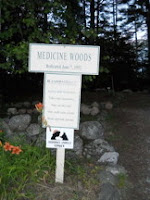 |
| Wintergreen |
To understand how wild plants are regarded and used by Native Americans, it is important to understand The Circle and its central position in the Native world view.
The Circle:
People and Plants are part of the Sacred Circle.
When visitors come to Mt. Kearsarge Indian Museum, one of the first things they do is watch an introductory video in The Silverstar Memorial Auditorium. (For more information about Chief Sachem Silverstar and the role he played in the founding of MKIM, see our post of August 27, 2010.)The video begins with a quote that is attributed to Si'ahl, also known as Chief Seattle, great Chief of the Dkhw’Duw’Absh (Duwamish) people.
"Every part of the earth is sacred to my people . . . every shining pine tree, every sandy shore, every light mist in the dark forest, every clearing . . . and every winged creature is sacred to my people. We are part of the earth and the earth is part of us. The fragrant flowers are our sisters. The deer and mighty eagle are our brothers. The rocky peak, the fertile meadows – all things are connected like the blood that unites a family."
The circle is a very important symbol to American Indians. It represents their belief that everything (plants, animals, people, sky, water, soil, etc.) is interconnected – part of a circle. The circle also represents equality to native people; in a circle, no one occupies a position greater than anyone else's.
Circles exist everywhere in nature. Night follows day, and day follows night. The seasons of the year roll on in an unending cycle. Rain falls on the soil, flows into rivers and lakes, then evaporates and forms clouds from which the rain falls again. Life cycles of animals include eggs, young, adults, and eggs again.
 |
| Maidenhair Fern |
Indians understand that we all depend on the environment for survival, and they treat the environment with tremendous respect. Though many of us do not live as close to nature as the early Native Americans did, we still depend on it as the sole source of the things we need for our survival.
Native Americans have traditionally lived as part of nature, not apart from it, as we so often do today. It has long been the custom of native people to take only what they need, and to waste nothing.
What a powerful example North America's first people have set for us.

